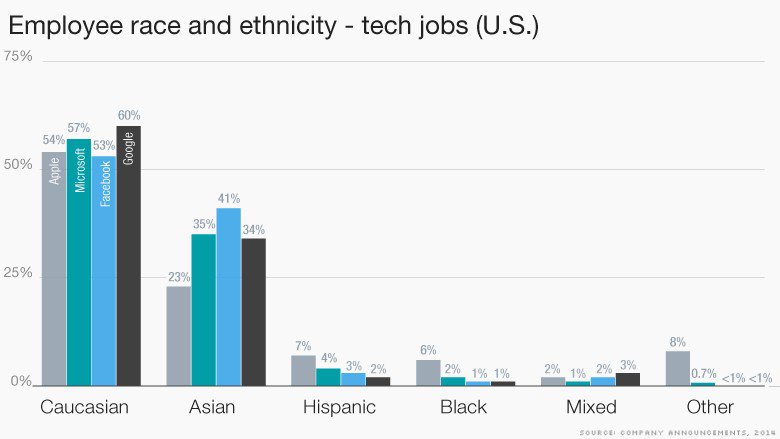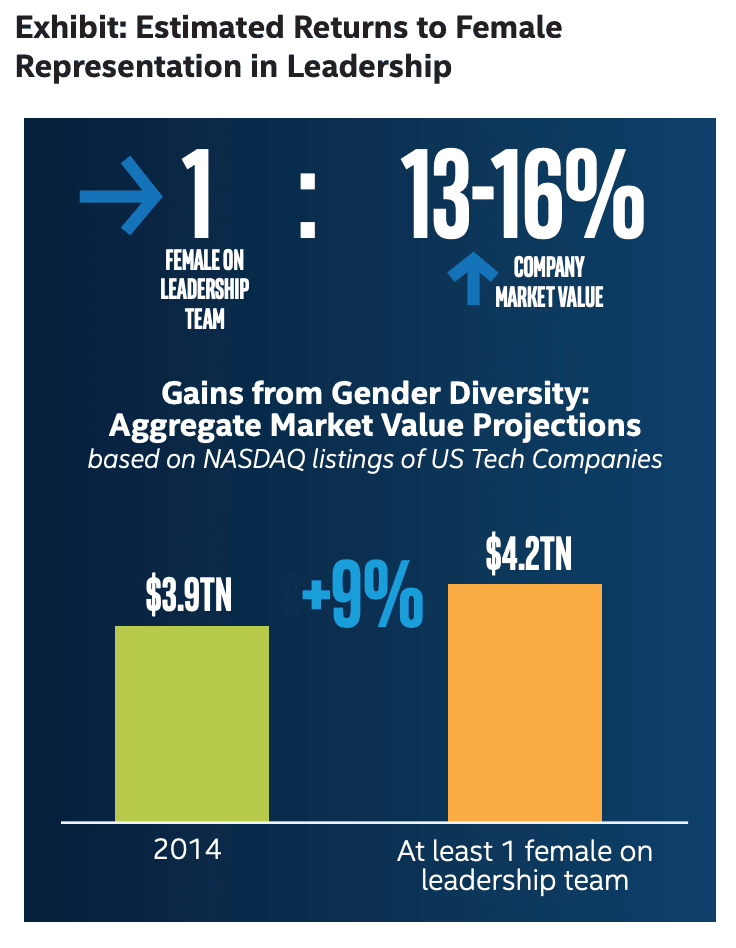Perché la diversità e la rappresentanza sono importanti nell'industria tecnologica
Diversità: un tema di cui il mondo tecnologico parla da decenni. Ci sono panel alle conferenze, libri, podcast e molto altro ancora dedicato all'argomento.
Eppure, i numeri sono ancora piuttosto scoraggianti.

Marginalized groups – namely women and minorities – are still severely underrepresented in tech.
Perché? E come possiamo risolvere il problema?
Let’s explore. 👇
Il dilemma della diversità
Se si guarda ad alcune delle aziende top della Silicon Valley, queste sono in maggioranza maschili e in maggioranza bianche (con la stragrande maggioranza delle aziende che hanno una forza lavoro inferiore a 10% neri e/o Latinx).
Of the $85 billion invested by venture capitalists in 2017, only $1.9 billion went to women-led teams – that’s 2.2% in total. 👎
E anche le squadre di genere misto (o di genere non confermato) hanno raccolto solo 19% di quella cifra di $85 miliardi.
When it comes to the racial disparities in funding, there’s a wide gap in the number of black and Latinx investment professionals who work at VC funds – the number was as low as 3% in 2016.
And we haven’t even mentioned the pay gap yet. 💸
Le donne che svolgono professioni STEM guadagnano in media $16.000 euro in meno all'anno rispetto ai loro colleghi maschi.

Oppure, se siete neri o latini e lavorate in una professione STEM, potreste guadagnare $14.000 euro in meno del vostro collega bianco.
Noticing a pattern? 🤔
Come siamo arrivati qui?
If we look at Emily Chang’s Brotopia, an insightful and well-researched book that chronicles the major gender disparities in Silicon Valley, it wasn’t always this way.
By the time the Macintosh was introduced in the 1980s, women were earning 40% of computer science degrees. 👩💻
A questo punto, le donne pioniere della tecnologia erano numerose. Dopo tutto, la prima riga di codice per computer fu scritta da Ada Lovelace negli anni '40 del XIX secolo.
Ma poi c'è stato un cambiamento.

“Just as computers began to head into the mainstream, women’s participation in the field started to plummet,” Chang writes.
Nell'ultimo decennio circa, la percentuale di donne laureate in informatica è rimasta stabile intorno al 22%.
Naturalmente, i fattori in gioco sono molteplici.
It goes beyond sexism or racism. There are microaggressions happening all the time in tech company offices – what’s frustrating about this is that it can sometimes be hard to pinpoint or call out.
Ad esempio, le donne ingegnere devono affrontare 35% un maggior numero di rifiuti del loro codice.
And from an anecdotal standpoint, another example would be infamous VCs holding parties that would make women uncomfortable, though of course, to men, it’s just a way for them to see if entrepreneurs can “hang.”
La mancanza di modelli di ruolo può essere un altro fattore. Ci sono poche, pochissime donne e minoranze ai vertici delle aziende tecnologiche.

It can also be chalked up internalized doubt. Many marginalized people, if not all in some way or another, are socialized and educated in subtle ways throughout their lives to doubt themselves (thankfully, this is being tackled by organizations such as Endeavor – check it out!).
This can often come in the form of “Impostor Syndrome,” a phenomenon that describes the feeling of being undeserving of your success, an “impostor.”
Il fenomeno colpisce in modo sproporzionato le donne e le minoranze, ma in una cultura aziendale che incoraggia le persone a vendere idee e a gonfiare il proprio valore, questo è problematico.

There are, of course, many other tangible and intangible factors as well. A person’s upbringing can greatly impact the way they perceive their career path.
For example, something seemingly harmless such as giving dolls to young girls and Legos to young boys can further exacerbate outdated gender roles. 🙅♀️
Ma detto questo, come sarebbe il mondo della tecnologia se fosse più diversificato?
There’s truth in the numbers
Beyond the obvious “it’s the right thing to do” mindset of having more diversity and representation in the tech world, it also just makes good business sense.
A study from McKinsey & Company found that companies in the top quartile for gender or racial and ethnic diversity are “more likely to have financial returns above their national industry medians.”
E il quartile inferiore di queste dimensioni? Hanno statisticamente meno probabilità di ottenere questi rendimenti.

As mentioned in their findings, “diversity is probably a competitive differentiator that shifts market share toward more diverse companies over time.”
From a financial standpoint, according to Forbes, female tech entrepreneurs are able to generate 20% more revenue than their male counterparts – despite starting their companies with 50% less capital. 💪
On top of that, the European Commission calculates that through the further inclusion of women working in tech, the EU’s GDP could see an annual boost of €16 billion.
The numbers are even more incredible in the US. In Intel’s Decoding Diversity report, they concluded, as we’ve already seen, that diversity leads to higher revenues, profits and market value.

Ma va anche oltre: migliorando la diversità e inclusione etnica e di genere nella forza lavoro tecnologica statunitense, si potrebbero creare tra $470 miliardi e $570 miliardi di nuovo valore per il settore.
That’s a lot of zeros. 😲
Andare oltre i numeri
Allora, perché la diversità porta risultati migliori?
Perché la somiglianza uccide l'innovazione.
La diversità nel modo in cui i team pensano e risolvono i problemi produce un successo maggiore.
Una migliore rappresentanza dei gruppi emarginati è fondamentale per trovare le giuste soluzioni alle sfide, per il pensiero creativo e per il successo generale dei clienti.
Quando i membri del team sono troppo simili, le cose possono sfuggire o essere trascurate.
Let’s put it this way: diverse teams win more often and more consistently.
Inoltre, avere team più eterogenei significa che l'azienda è al servizio di tutti i clienti, non solo di se stessa.
Il mondo è pieno di persone con una pletora di background e prospettive diverse. Per creare e costruire un'azienda che sia al servizio di tutti, i team devono ascoltare chi ha esperienze diverse.
Dove andiamo a finire?
There are already some companies and government organizations that are pushing for more representation in the tech industry – but it needs to go further (and not just result in simple quotas).
Going back to Cheng’s Brotopia, she suggests:
- nomina di donne nei consigli di amministrazione,
- assunzione di un maggior numero di donne partner
- e l'assunzione di un maggior numero di donne venture capitalist.
- Lo stesso dovrebbe essere fatto per tutti i gruppi emarginati, ovviamente.
But most importantly: the tech industry needs to stop blaming everyone else for the problem. 😕
Nella Silicon Valley, il fallimento è qualcosa che viene celebrato perché può aiutare a imparare (e alla fine ad avere successo). Tuttavia, i gruppi emarginati sono stati bocciati dall'industria tecnologica per troppo tempo.

As Cheng explains, “it’s time for the industry to own it.”
I dati hanno dimostrato più volte che una forza lavoro più diversificata non solo è più efficiente e redditizia, ma offre anche alle aziende la possibilità di ascoltare prospettive che prima non erano presenti.
It’s crucial for companies to have more intersectional voices heard across the tech industry, especially in leadership functions, and to encourage more diversity to ensure that they are creating solutions and technology for the modern world: one that is filled with people from different walks of life.
Risolveremo il problema con questo singolo post? Ovviamente no.
But we need to be having these conversations. And more importantly, we need to be doing something about it. 🗣

We can speak at diversity panels until our faces turn blue, but until those in the higher echelons of the tech world encourage and drive the conversation – and take meaningful actions for change – things are going to remain the status quo.
And, well, that’s just bad business. 🤷♀️
Speriamo che questo post vi sia piaciuto. Se vi è piaciuto, spargete la voce!
Per ulteriori informazioni su startup, growth marketing e vendite:
👉 follow @salesflare on Twitter o Facebook
- 22+ Best Sales Podcasts You Should Check Out in 2024 - 21 Dicembre 2023
- Scritture di chiamata a freddo per esseri umani reali - 21 settembre 2023
- Gli oltre 25 migliori strumenti di vendita per aiutare il vostro team ad avere successo - 10 Agosto 2023
